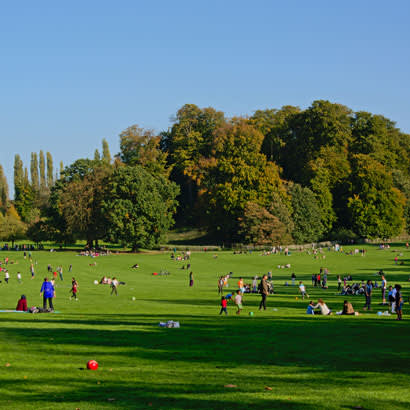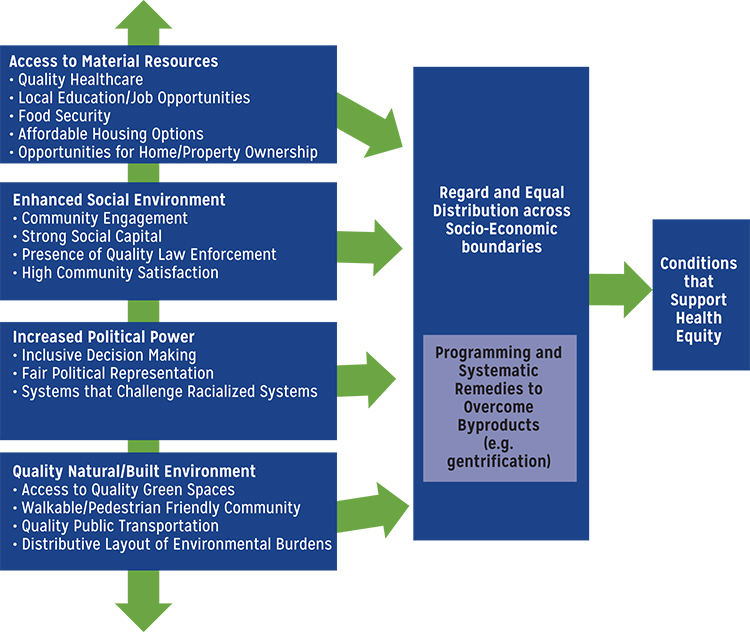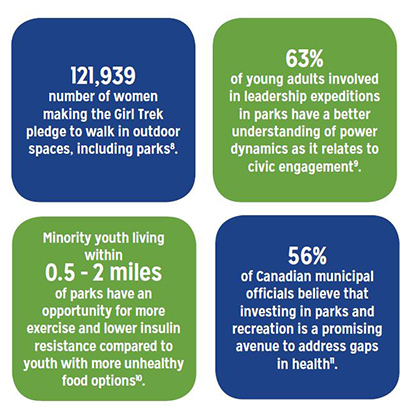
Marginalized areas often have poor access to quality parks. This limited access to green space can negatively impact public health and well-being, especially in communities already facing numerous challenges to success. The term “health disparities” refers to major gaps in health between different groups.
Typically, health disparities arise in groups that experience systemic obstacles to their quality of life based on race or ethnicity, socioeconomic status, age, gender, physical or mental disability, geographic location, or forms of discrimination or exclusion. Addressing these systemic obstacles — and the disparities they create — requires perspectives rooted in health equity. Parks and greens pace strategies need to be part of these solutions.
A growing body of scientific evidence suggests that access to parks and green space may alleviate health disparities observed in vulnerable populations. For example, studies have shown that access to urban parks is associated with lower risk of obesity, cardiovascular disease, diminished mental health and other health-related concerns. Since health equity involves the “attainment of the highest level of health for all people,” there is an opportunity to be more thoughtful about the role parks can play in promoting wellness.
Our recent commentary, published in the International Journal of Environmental Research and Public Health, describes how parks are related to various dimensions of health equity. For example, quality parks can enhance the quality of life in ways that encourage people to explore the outdoors, meet others and engage in various types of physical activity or exercise. Figure 1, “Illustration of factors that support health equity,” is from the article and illustrates the link between green spaces and some dimensions of health equity:

Quality parks are just one aspect of health equity at the community level. Building a holistic and achievable vision of health equity requires collaboration from a wide range of perspectives, and parks are an important piece of the puzzle. They can promote youth engagement, walkability, job creation, environmental quality and social improvements. Parks can deliver safe and affordable venues for physical activity. Supporting active and passive recreation opportunities for people of all ages readily allows parks to serve as tools for physical and mental health promotion. However, the wide range of health benefits associated with parks can’t be fully realized when the needed resources are distributed inequitably across communities based on racial, socioeconomic or geographic factors. For instance, studies often find lower-quality parks, with fewer amenities, like playgrounds, in lower-income communities — if they are present at all.
Efforts to reduce play deserts, which pertain to areas with limited access to play spaces, such as parks, green spaces or recreation centers, are an avenue to increase exposure to the health benefits of parks, such as improved physical activity, socialization and stress reduction. As new parks are established in underserved communities, the implementation of holistic strategies is needed to pair park development with efforts to address housing affordability, quality schools and other measures aimed at addressing the social determinants of health so that the populations that can most benefit from new park developments reap the benefits “in place.” These coordinated and collaborative strategies, especially in urban centers undergoing revitalization, can put park engagement at the intersection of effective efforts to advance health equity.
The following infographic includes highlights from related research and initiatives on green space and health:

“Green spaces can support placed-based strategies to relieve urban health concerns,” says Dr. Michelle Kondo, a research social scientist with the USDA Forest Service. “This can be particularly important in blighted areas that are characterized with vacant lots and overarching social concerns that challenge well-being.”
While parks can support health promotion, other studies have discussed concerns about gentrification that could lead to displacing residents who are priced out of their homes because of increasing property values. Broader conditions, where people are born, live, work and age, often described as social determinants of health, are shaped by the distribution of power, money and other resources. These social determinants can have major implications at local, national and global levels.
Many communities around the country are developing strategies to eliminate health disparities by promoting health equity. Given the outsized role quality parks and green spaces can play in promoting health and wellness, involvement of park professionals and researchers in collaborative efforts to promote community health is crucial. Efforts to achieve health equity through parks can be successful, but they will be more so if diverse perspectives and groups of people are at the table.
Viniece Jennings, Ph.D., is a Research Scientist with the USDA Forest Service. Na’Taki Osborne Jelks, Ph.D., MPH, is an Assistant Professor in the Environmental and Health Sciences Program at Spelman College. James Dills, MUP, MPH, is a Health Integration Associate in the Georgia Health Policy Center at Georgia State University.
References
- National Recreation and Park Association. Parks & Recreation in Underserved Areas: A Public Health Perspective. (Ashburn, VA, 2012).
- DHHS. Healthy People 2020 - Definition of Health Disparities, (2010).
- Jennings, V., Baptiste, K. A., Osborne Jelks, N. & Skeete, R. "Urban Green Space and the Pursuit of Health Equity in Parts of the United States." Int. J. Env. Res. Public Health 14, (2017).
- Tsui, E. K. Sectoral job training as an intervention to improve health equity. Am. J. Public Health 100, S88-S94 (2010).
- Starfield, B. & Birn, A.-E. "Income redistribution is not enough: income inequality, social welfare programs, and achieving equity in health." J. Epidemiol. Community Health 61, 1038-1041 (2007).
- Northridge, M. E. & Freeman, L. "Urban Planning and Health Equity." J. Urban Health 88, 582-597 (2011).
- Jennings, V., Larson, L. & Yun, J. "Advancing Sustainability through Urban Green Space: Cultural Ecosystem Services, Equity, and Social Determinants of Health." Int. J. Env. Res. Public Health 13, 196 (2016).
- Collins, P. A. & Hayes, M. V. "Examining the capacities of municipal governments to reduce health inequities: A survey of municipal actors’ perceptions in Metro Vancouver." Can. J. Public Health 104, e304-e310 (2013).
- Hsieh, S. et al. "Fast-Food Restaurants, Park Access, and Insulin Resistance Among Hispanic Youth." Am. J. Prev. Med. 46, 378-387, (2014).
- Wood, I. Freshtracks - Sharing Cultures, Igniting Futures, (2017).
- GirlTrek, (2017).

